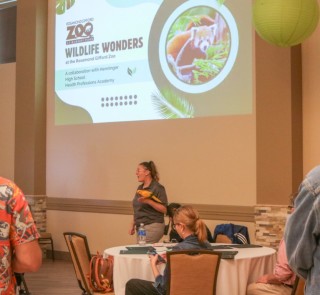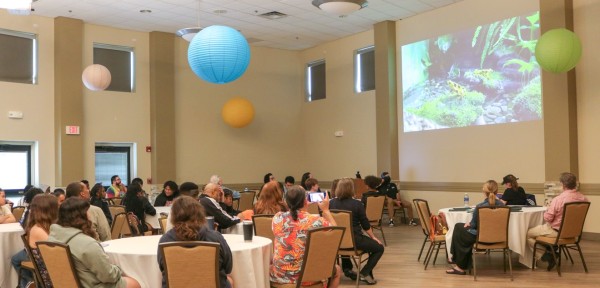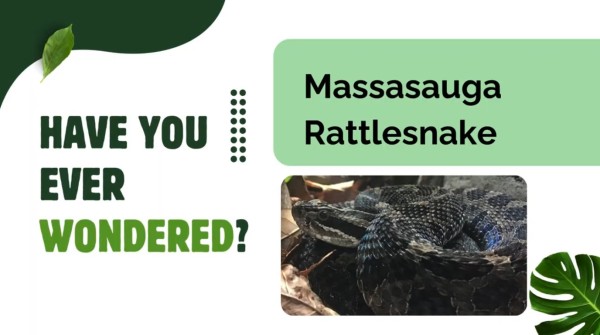Henninger High School Students Bring Wildlife Wonders and Career-Readiness to the Rosamond Gifford Zoo
On June 6, 2024, a group of ninth-grade students from Syracuse City School District’s (SCSD) Henninger High School, in partnership with The Manufacturers’ Association (MACNY) and Partners for Education & Business (PEB), celebrated the completion of their capstone projects that were a year in the making— Wildlife Wonders at the Rosamond Gifford Zoo. The students were part of Pathways for Technology Early College High School (P-TECH) program. The project aimed to provide students with hands-on, project-based learning experience as they consider the many possibilities of pursuing a career in the health professions. In celebration of their accomplishment, the students gathered at the zoo to view their finished videos together and to receive their certificates before touring the zoo. Nueve, the golden conure, even joined the fun as Sarah Kohler, Senior Ambassador Animal Specialist at the Friends of the Rosamond Gifford Zoo, delivered an informative creature chat.

All year long, these students worked together to explore the variety of technical and communicative skills it takes to be career-ready, culminating in each group of students creating an informative video about an animal species living at the Rosamond Gifford Zoo. Some featured species included the Panamanian golden frog, Meishan pig, eastern hellbender, eastern massasauga rattlesnake, patas monkey, helmeted curassow, and Moholi bushbaby. The species, which are often less positively perceived by the public, were purposefully selected to help students develop empathy for them. Empathy helps foster more positive behaviors towards the animals, inspiring a lifelong love for wildlife and support for conservation efforts.
Rather than confining learning to the classroom, this project aimed to supply students with the chance to step into a new environment at the zoo so they could engage with their work and each other in new, collaborative ways. Students participated in the zoo’s Project-Based Learning: Conservation in Action Voyage. “Project-based learning empowers students to take control of their education through a hands-on approach, helping them develop real-world skills such as receiving feedback, working in groups, and managing time. By collaborating with job coaches and worksites, they not only explore careers but also gain early awareness of different fields, guiding them toward potential career paths,” said Kim Arnold, Director of Education at the Friends of the Rosamond Gifford Zoo. “From my own experience,” Arnold reflected, “I know that a straight line to a career is rare, and early exposure helps students understand their interests and strengths while giving them the confidence to explore different possibilities. These projects also enhance communication skills, particularly public speaking. I especially enjoy teaching students to ‘fail forward.’ In a world that can be tough, they learn that what they once saw as failure is actually a stepping-stone to creating meaningful change and improvement.”
Setting the project at the Rosamond Gifford Zoo was a strong draw for the students. To be able to learn about the animals living at the zoo sparked their curiosities and inspired their projects. The students learned about how the Rosamond Gifford Zoo provides exceptional and specialized care to each animal, works to conserve animals in the wild through breeding programs, and engages the public to spread the message of conservation from the “Why Zoos Matter” course offered on-site at the zoo. Additionally, Mary Rice, Senior Education Coordinator at the Friends of the Rosamond Gifford Zoo, brought the mobile Zoo to You program to students, helping solidify the concepts they learned with engaging biofacts. In each video, students asked their viewers the question, “Have you ever wondered…” about animals’ unique behaviors and physiologies. As they dove into the science of North American river otters’ fur coats or patas monkeys’ long limbs, students discovered how important animals’ adaptations can be to their survival and the specific role each animal plays in its natural habitat. Along the way, Arnold provided feedback to help students reach their academic potential from the start of the project to the final showcase.

As part of the program, students were tasked to research an animal species, write a script that educates a viewer about the behavioral and physical adaptations of that species, film a short segment of the animal at the zoo, present their script through a voice-over performance, and edit the segments into a polished video. Not only did each step of the process offer students the chance to develop technological prowess and expand their scientific knowledge, but they also focused on developing several soft skills that are advantageous to nearly any career path, such as navigating collaborative team dynamics, committing to a long-term project, communicating effectively, delegating responsibility, demonstrating curiosity, and more. In fact, students didn’t need to look far to see just how important teamwork is when on the job. This project would not have been possible without the cooperation between a variety of professional organizations. SCSD project coordinators and teachers, MACNY employees, volunteer career coaches, and Friends of the Rosamond Gifford Zoo team members closely collaborated during the year to support students every step of the way. In the words of Amy Stewart, MACNY Workforce Development Specialist, “It takes a village!”
Throughout the project, a career coach volunteer led each group, offering mentorship, guidance, and encouragement during their monthly meetings. “It’s hard to say in ninth grade that you know exactly what you want to do,” explained Adrienne Hickey, the Associate Director for Respiratory Care at Upstate Medical Center, who has served as a career coach volunteer since 2018. This year, she coached the group that worked on the helmeted curassow, a large bird endemic to Venezuela and Columbia that is currently listed as vulnerable to extinction by the International Union for the Conservation of Nature (IUCN). “What we do know is that you need computer skills, you need teamwork skills, you need public speaking skills, and so on,” she listed. “So having the chance to deliberately practice all that is important and impactful.” By carving out dedicated time to practice those skills, students also gain confidence. Rather than wait until graduation, students can explore a variety of career paths while still in high school, learning about their own interests, motivations, and aspirations in a safe and supported environment. “Part of the program’s goal is to encourage students to consider all the different career paths that don’t always seem as obvious. Being there and seeing it ‘for real’ can open up a lot of opportunities.” Over the course of the year, Hickey noted, many students expressed enthusiasm for careers that involve wildlife conservation.
Hickey went on to praise how students rose to the challenge of completing their year-long project together. “At the start of the project, we were strangers. Students can even come across as standoffish during that stage. Having the [helmeted curassow] video as our common goal we all shared helped to keep us focused on our task and get to know each other so we could work as a team.” Delegation for certain tasks was key to creating the video. Some students gravitated towards the public-speaking elements of the project, whereas other preferred research activities or editing the presentation slides. Instead of being told what to do, students were encouraged to test out different activities to figure out what they enjoyed and why. Each component clearly showed up in the final videos, meaning that students were able to share in the rewarding satisfaction that comes from seeing a project from conception to completion.
According to Dr. Eli Feathers, Physical Therapist at Upstate Medical Center and Volunteer Career Coach, building in the space for exploration during the duration of the program was key for students. “I think that sometimes, students are almost surprised that we want to know what they’re thinking,” he recalled. “They have questions and interests, but it’s not often young people are encouraged to speak up and to ask those questions or to express that interest. When we’re together, that’s what it’s all about. This project can’t happen without everyone’s voice being represented. Once we overcome that surprise and dig in together, it is a really empowering experience for students.” Both Feathers and Hickey underlined that the project offered students the chance to gain real-life experience that they can take with them into any field or future endeavor.
We are grateful to have had the opportunity to aid these Henninger High School students in their career journeys. Congratulations to all the students and career coaches for completing their projects and sharing their newfound knowledge with each other!
Interested in discovering how your students can participate in project-based learning at the Rosamond Gifford Zoo? Visit https://www.rosamondgiffordzoo.org/learn/for-educators-and-groups/ for more information.




